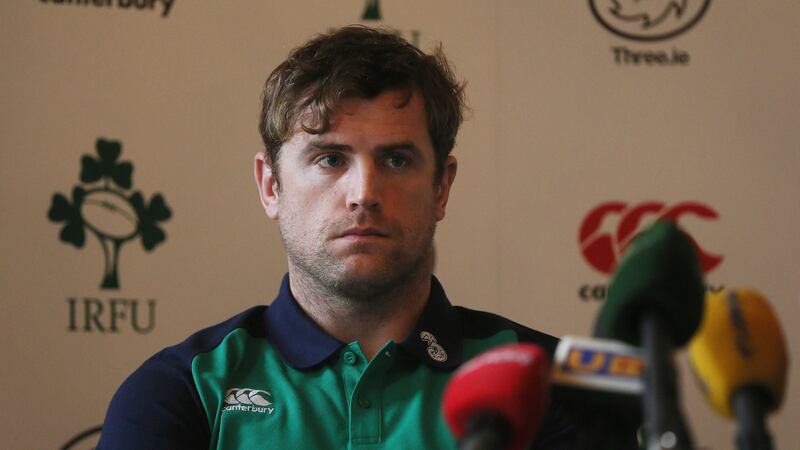I’M SITTING writing this in the press working room at the Aviva Stadium. My stomach is full. Cottage pie, potatoes, rice. As much of it as you please.
There are strange faces all around me, chewing over both the grub on offer and the fat of Ireland’s Six Nations clash with Wales, which kicks off 90 minutes from now. Last Friday, a media schedule for the week popped into the email inbox. Ireland will hold four press events, it says. Monday, Tuesday, Wednesday and Friday.
At Carton House during the week, I’m the rabbit in the headlights. New to it all. Rory Best is standing in the foyer, just having a chat with Gerry Thornley. Down through the ageing, narrow corridors of the old, but extremely plush, hotel, Devin Toner leans against the fireplace, picking the bones with Michael Corcoran.
Four days before they play Wales, it’s an open, welcoming environment. When the players are presented for interview, they are engaging. They don’t appear to carry any fear of the media. You do sense a dislike in some cases, but at least both sides come out and face it up.
In rugby, teams are not afraid to talk about the game in detail. The Welsh camp spoke this week about how they expected Ireland to test their fledgling back three with an aerial assault. Of how they had changed their front row because of the selection of Jerome Garcés as referee.
Ireland reiterated Wales’ ability to hold on to men illegally in a ruck and get away with it. The mind games are constant. After the game on Sunday evening, Joe Schmidt, Rory Best, Warren Gatland and Sam Warburton were presented to the media half-an-hour or so after the final whistle.
Just before that, three sheets were passed to every member of the press. They told us how many tackles each side made, how many turnovers there were, how many ball carries, metres made.
Statistics. That’s win or lose.
It’s the same at the Kingspan Stadium. Every Tuesday without fail, Ulster produce a coach and three or four players for interview. It ensures them coverage for the rest of the week. Reporters filter the interviews out over the three or four days running up to a game. The photos go alongside. Ulster’s sponsors, as a result, get coverage on a daily basis.
The media easily adapted to the rebranding of Ravenhill as the Kingspan Stadium because Ulster go out of their way to make a reporter’s job easy. Rugby goes out of its way to make a reporter’s job easy.
Compare that to the GAA. Picture the conversation: PRO: “We’re going to release the stats from the game to the press.”
Manager: “Jesus, we can’t be telling them Billy won six breaks, someone will mark him next week.”
As if no-one owns a DVD player these days. That is one side of it. But consider also what businesses gain in terms of publicity from having their name attached to GAA teams in comparison to what rugby’s sponsors are afforded.
Kingspan are the obvious example. How often does anyone refer to Breffni Park with its official prefix? The give-and-take does not exist in GAA in the same way it does in other sports and, as a result, sponsors are being increasingly short-changed.
Counties are always keen to give themselves exposure. They always hope that it’s in the positive sense. And they are no different from those in professional sports who attempt to turn bad news away where possible. But the general relationship between the media and the counties themselves can be quite strained now.
It must be said that I’ve never rang an inter-county manager and had a less than courteous response. They do understand that it comes with the territory and, 99 per cent of the time, they will speak.
There are some extremely nice men in inter-county management. There are also some exceptional PROs, particularly in Ulster. You will find no volunteer who works harder than Derry’s Dermot McPeake.
Last week, he penned a brilliant article on Eoghan Rua’s hurlers and their club’s voyage to Croke Park, purely because he wanted to give the club the publicity they merited. But certain counties - with a nod to some of the more successful ones - only do press events outside of matchday when their players are being paid to promote a product. Otherwise, it’s access denied.
There was the rather ludicrous situation recently where Armagh boss Kieran McGeeney told members of the press that he couldn’t speak after their defeat by Meath because his PR team didn’t allow him. The fact that the GAA continues to get so much coverage on a daily basis is almost in spite of itself.
There are obvious differences in terms of what can be done. Most Gaelic players work during the day. The rest are employed by their county board. It’s not so handy for GAA players to rock up to Garvaghey on a Tuesday afternoon and smile for the cameras. Everyone recognises that.
And we’re the ones getting paid to do this, while the poor player gets nothing but grief at training on a Tuesday night for having his face stuck in the paper again. We know that too. But the GAA must seriously look at its approach to the media as a whole.
In an era where so many of its processes are closing in on professional – and for the better – they lag badly behind when it comes to making sure they’re on the back page.







